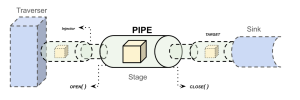In the realm of data science and analytics, the significance of graph processing cannot be overstated. The intricate web of relationships and connections that graphs represent are fundamental to understanding complex systems, from social networks to biological interactions. However, the inherent challenges of processing and analyzing graph data, particularly at scale, have necessitated the development of innovative computational models and frameworks. In this context, we introduce GraphMa, our approach for pipeline-oriented graph processing.
The Essence of GraphMa
At its core, GraphMa is a conceptual framework that seamlessly merges the principles of pipeline computation with the intricacies of graph processing. It introduces a series of powerful abstractions that empower developers to decompose complex graph operations into modular, composable functions. These functions can then be orchestrated into streamlined pipelines, facilitating the systematic development and execution of graph algorithms.

The Building Blocks of GraphMa
- Computation as Type: This foundational abstraction elevates computation units to first-class entities, encapsulating them within a well-defined interface. This approach ensures type safety and promotes modularity, enabling the creation of reusable and composable pipeline stages.
- Higher-Order Traversal Abstraction: This abstraction provides a versatile mechanism for navigating and accessing data within graphs. It defines methods for traversing various data sources, empowering developers to manipulate and process graph data with flexibility and efficiency.
- Directed Data-Transfer Protocol: This protocol governs the seamless and efficient transfer of data between computational stages. It adheres to functional programming principles, ensuring clear directionality and optimized data flow throughout the pipeline.
- Operator Model: This model introduces a comprehensive set of constructs for managing the lifecycle and states of operators within the pipeline. It facilitates a wide array of data processing operations, from transformations to aggregations, enabling the construction of sophisticated graph algorithms.
- Pipeline Abstraction: This abstraction serves as the overarching framework that orchestrates the entire graph processing workflow. It encapsulates the complexities of data transformation and transmission, providing a high-level blueprint for defining and executing graph processing pipelines.
Embracing Established Computational Models
GraphMa’s versatility shines through its ability to seamlessly integrate well-established computational models for graph processing. Whether it’s the vertex-centric model, where computations are centered around individual nodes, or the edge-centric model, which focuses on the relationships between nodes, GraphMa provides a flexible platform for implementing and executing these models within its pipeline-oriented architecture.
The Promise of GraphMa
GraphMa represents a significant leap forward in the field of graph processing. By combining the power of pipeline computation with graph-specific abstractions, it offers a structured and modular approach to tackling the challenges of graph data analysis. Its potential to enhance scalability, efficiency, and expressiveness in graph processing tasks positions it as a valuable tool for researchers and practitioners navigating the complexities of interconnected data. As GraphMa continues to evolve, we can anticipate its widespread adoption and its transformative impact on the way we understand and leverage the power of graphs in the digital age.
References
Schroeder, Daniel Thilo, Tobias Herb, Brian Elvesæter, and Dumitru Roman “GraphMa: Towards new Models for Pipeline-Oriented Computation on Graphs.” In Companion of the 15th ACM/SPEC International Conference on Performance Engineering, pp. 98-105. 2024.

